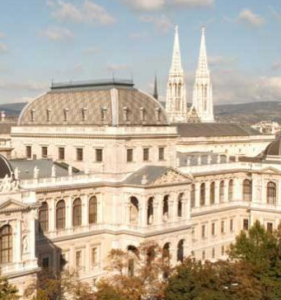International Conference at the Department for Art History, University of Vienna
(Ingeborg Schemper, Julia Rüdiger, Andrea Mayr, Martin Engel)
Wednesday, Sep 24 – Friday, Sep 26, 2014
Deadline: Feb 28, 2014
 At the occasion of the 650th anniversary of the founding of the University of Vienna in 2015 an international conference at the Department of Art History will focus on scholars’ monuments from an interdisciplinary point of view. Within this scope current research positions in art and cultural history will be presented and reflected in the context of the Arcaded Courtyard at the University of Vienna, one of the largest high quality halls of honour in university context.
At the occasion of the 650th anniversary of the founding of the University of Vienna in 2015 an international conference at the Department of Art History will focus on scholars’ monuments from an interdisciplinary point of view. Within this scope current research positions in art and cultural history will be presented and reflected in the context of the Arcaded Courtyard at the University of Vienna, one of the largest high quality halls of honour in university context.
This arcaded courtyard at the centre of the main building fulfils not only the function of a crossing point for communicative processes, but with its more than 150 professors’ monuments it is one of the most important memorial for the Austrian history of science and humanities. Despite its great significance as a commemorative space and the partly superior artistic quality of its exhibits, neither the site as a whole nor the individual busts have yet been made the subject of a comprehensive art-historical treatment. The same applies to numerous European university and academic « halls of honour ».
The conference aims to highlight scholars’ memoria from an international and comparative point of view. Suggested topics may be approached from different methodological viewpoints (e.g. Art History, Contemporary History, History of Sciences, Cultural Memory Studies, Gender Studies). In this context not only the tradition of university halls of honour as “functional memory” becomes apparent, but also the practice of selecting (and excluding!) scientists becomes visible. Through this research strategies of ideological or gender motivated exclusion can be identified in particular. Another important aspect in this debate will be the historical and up-to-date significance of the monument for individuals and its future potential.
We welcome and encourage proposals to the following topics:
1. The origins and the characteristics of collective scholars’ memoria since early modern times. The development of specific types of halls of honour and pantheons. Which functions do these pantheons fulfil in the self-conception of scientific institutions? Which tasks do those scholars’ ensembles have in a social context, e.g. in comparison to military halls of honour?
2. Comparative case studies on scholars’ monuments in Europe that are remarkable from the iconographic, typological or stylistic view. Which stylistic or iconographic forms are particularly suitable in order to highlight scientific achievements? Which role does the setting of monuments play in the estimation of sciences?
3. Scientific considerations on the future of scholars‘ memoria. Is the bust an endangered species of monuments? What will monuments for (female and male) scientists look like in the 21st century?
400 words proposals for 30 minutes papers (in English or in German with a brief CV) should be submitted by March 15, 2014 to the organisation team: scholarsmonuments.kunstgeschichte@univie.ac.at
It is intended to publish a selection of the contributions in the Wiener Jahrbuch für Kunstgeschichte (peer-reviewed).
Travelling and accommodation costs of the speakers will be – dependent on the available financial resources – refunded.
URL de référence : http://arthist.net/archive/6881

Leave a Reply
You must be logged in to post a comment.